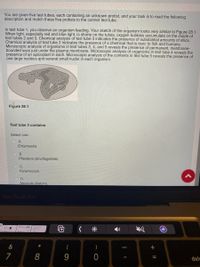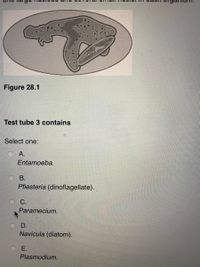
Human Physiology: From Cells to Systems (MindTap Course List)
9th Edition
ISBN: 9781285866932
Author: Lauralee Sherwood
Publisher: Cengage Learning
expand_more
expand_more
format_list_bulleted
Question
If you can please help me I will give you ?

Transcribed Image Text:You are given five test tubes, each containing an unknown protist, and your task is to read the following
description and match these five protists to the correct test tube.
In test tube 1, you observe an organism feeding. Your sketch of the organism looks very similar to Figure 28.1.
When light, especially red and blue light, is shone on the tubes, oxygen bubbles accumulate on the inside of
test tubes 2 and 3. Chemical analysis of test tube 3 indicates the presence of substantial amounts of silica.
Chemical analysis of test tube 2 indicates the presence of a chemical that is toxic to fish and humans.
Microscopic analysis of organisms in test tubes 2, 4, and 5 reveals the presence of permanent, membrane-
bounded sacs just under the plasma membrane. Microscopic analysis of organisms in test tube 4 reveals the
presence of an apicoplast in each. Microscopic analysis of the contents in test tube 5 reveals the presence of
one large nucleus and several small nuclei in each organism.
Figure 28.1
Test tube 3 contains
Select one:
A.
Entamoeba.
B.
Pfiesteria (dinoflagellate).
Paramecium.
D.
Navicula (diatom).
MacBook Pro
&
7
8
9
del

Transcribed Image Text:Figure 28.1
Test tube 3 contains
Select one:
А.
Entamoeba.
В.
Pfiesteria (dinoflagellate).
С.
Paramecium.
D.
Navicula (diatom).
Е.
Plasmodium.
Expert Solution
This question has been solved!
Explore an expertly crafted, step-by-step solution for a thorough understanding of key concepts.
This is a popular solution
Trending nowThis is a popular solution!
Step by stepSolved in 3 steps

Knowledge Booster
Learn more about
Need a deep-dive on the concept behind this application? Look no further. Learn more about this topic, biology and related others by exploring similar questions and additional content below.Similar questions
- What type of micrograph is shown below? Is the organism pictured prokaryotic or eukaryotic? How can you tell?arrow_forwardProkaryotes stain as Gram-positive or Gram-negative because of differences in the_______. a. cell wall b. cytoplasm c. nucleus d. chromosomearrow_forwardFigure 13.6 Which of the following statements is true? a. Gram-positive bacteria have a single cell wall formed from peptidoglycan. b. Gram-positive bacteria have an outer membrane. c. The cell wall of Gram-negative bacteria is thick, and the cell wall of Gram-positive bacteria is thin. d. Gram-negative bacteria have a cell wall made of peptidoglycan, while Gram-positive bacteria have a cell wall made of phospholipids.arrow_forward
- A marine biologist analyzing water samples notices a protist with a calcium carbonate shell that moves by pseudopodia extension. The protist is likely to be closely related to which species? Fuligo septica (Dog Vomit slime mold) Circogonia icosahedra (Radiolarian) Eugiena viridis Ammonia tepidaarrow_forwardConjugation between two Paramecia produces total daughter cells. 2 4 8 16arrow_forwardWhich parasitic protist evades the host immune system by altering its surface proteins with each generation? a. Paramecium caudatum b. Trypanosoma brucci c. Plasmodium falciparum d. Phytophthora infrstansarrow_forward
- The term _________________________________ means pertaining to a virus. viral virilearrow_forwardExplain how the definition of protists ensures that the kingdom Protista includes a wide diversity of cellular structures. Provide an example of two different structures that perform the same function for their respective protist.arrow_forwardFigure 23.25 Which of the following statements about Paramecium sexual reproduction is false? The macronuclei are derived from micronuclei. Both mitosis and meiosis occur during sexual reproduction. The conjugate pair swaps macronuclei. Each parent produces four daughter cellsarrow_forward
arrow_back_ios
arrow_forward_ios
Recommended textbooks for you
 Human Physiology: From Cells to Systems (MindTap ...BiologyISBN:9781285866932Author:Lauralee SherwoodPublisher:Cengage Learning
Human Physiology: From Cells to Systems (MindTap ...BiologyISBN:9781285866932Author:Lauralee SherwoodPublisher:Cengage Learning Biology Today and Tomorrow without Physiology (Mi...BiologyISBN:9781305117396Author:Cecie Starr, Christine Evers, Lisa StarrPublisher:Cengage Learning
Biology Today and Tomorrow without Physiology (Mi...BiologyISBN:9781305117396Author:Cecie Starr, Christine Evers, Lisa StarrPublisher:Cengage Learning Microbiology for Surgical Technologists (MindTap ...BiologyISBN:9781111306663Author:Margaret Rodriguez, Paul PricePublisher:Cengage Learning
Microbiology for Surgical Technologists (MindTap ...BiologyISBN:9781111306663Author:Margaret Rodriguez, Paul PricePublisher:Cengage Learning

Human Physiology: From Cells to Systems (MindTap ...
Biology
ISBN:9781285866932
Author:Lauralee Sherwood
Publisher:Cengage Learning

Biology Today and Tomorrow without Physiology (Mi...
Biology
ISBN:9781305117396
Author:Cecie Starr, Christine Evers, Lisa Starr
Publisher:Cengage Learning




Microbiology for Surgical Technologists (MindTap ...
Biology
ISBN:9781111306663
Author:Margaret Rodriguez, Paul Price
Publisher:Cengage Learning